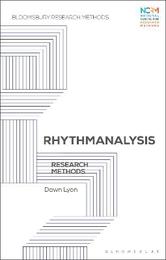
|
Rhythmanalysis: Research Methods
Paperback / softback
Main Details
| Title |
Rhythmanalysis: Research Methods
|
| Authors and Contributors |
By (author) Dr Dawn Lyon
|
| Series | Bloomsbury Research Methods |
|---|
| Physical Properties |
| Format:Paperback / softback | | Pages:144 | | Dimensions(mm): Height 216,Width 138 |
|
| ISBN/Barcode |
9781350188907
|
| Classifications | Dewey:301.072 |
|---|
| Audience | | Tertiary Education (US: College) | |
|---|
|
Publishing Details |
| Publisher |
Bloomsbury Publishing PLC
|
| Imprint |
Bloomsbury Academic
|
| Publication Date |
24 December 2020 |
| Publication Country |
United Kingdom
|
Description
First published Open Access under a Creative Commons license as What is Rhythmanalysis?, this title is now also available as part of the Bloomsbury Research Methods series. In recent years, there has been growing interest in Henri Lefebvre's posthumously published volume, Rhythmanalysis. For Lefebvre and subsequent scholars, rhythmanalysis is a research strategy which offers a means of thinking space and time together in the study of everyday life, and this remains its strength and appeal. This book addresses the task of how to do rhythmanalysis. It discusses the history and development of rhythmanalysis from Lefebvre to the present day in a range of fields including cultural history and studies of place, work and nature. For Lefebvre, it is necessary to be 'grasped by' a rhythm at a bodily level in order to grasp it. And yet we also need critical distance to fully understand it. Rhythmanalysis is therefore both corporeal and conceptual. This book considers how the body is directly deployed as a research tool in rhythmanalytical research as well as how audio-visual methods can get at rhythm beyond the capacity of the senses to perceive it. In particular, the book includes detailed discussion of research on different forms of mobility - from driving to dancing - and on the social life of markets - from finance to fish. Dawn Lyon highlights the gains, limitations and lively potential of rhythmanalysis for spatially, temporally and sensually attuned practices of research. This engaging text will be of interest to students and researchers in sociology, criminology, socio-legal studies, geography, urban studies, architecture, anthropology, economics and cultural studies.
Author Biography
Dawn Lyon is Reader in Sociology at the University of Kent, UK.
ReviewsIt is hard to imagine a more engaging, yet succinct introduction to Henri Lefebvre's rhythmanalysis. Surveying the most relevant cross-disciplinary work while continually demonstrating how rhythmanalysis is a practicable method, this book is illuminating and generative in equal measure. * Gregory J. Seigworth, Professor of Communication Studies, Millersville University, USA * Starting with Lefebvre's thought and tracing its evolution through the current times across the social sciences, Lyon's book presents rhythmanalysis as a family of concepts, a research strategy and a set of field practices intended to sensitize students and scholars to undertake empirical research with attention to the flows of rhythm. The book demystifies the often-misunderstood but ever so popular concept through clear and practical terms and examples, showing us how to better understand social life through the perspective of rhythm and the role of time in the production, imagination, experience, and representation of multiple social realities. * Phillip Vannini, Professor and Canada Research Chair, Royal Roads University, Canada * Dawn Lyon's invitation to consider the methodological benefits of adopting rhythmanalysis as a research tool is a no-nonsense, bracing account that generously treats readers to a wealth of empirical examples and theoretical ideas. Rescuing Lefebvre's contentions from the realm of arcane scholarly debate, Lyon provides a wide-ranging, lucid and convivial exploration that grounds rhythmic experience in everyday living while simultaneously extending ways in which rhythm may be conceptualised. * Tim Edensor, Reader in Cultural Geography, Manchester Metropolitan University, UK * A timely contribution. While rhythmanalysis to date has not been a well-defined methodology, or at least can as much reveal the idiosyncrasies of the researcher, her book offers a clear and thoughtful attempt to characterize what rhythmanalysis might actually look like for a wide range of researchers. * Sunil Manghani, Professor of Theory, Practice and Critique, University of Southampton, UK *
|